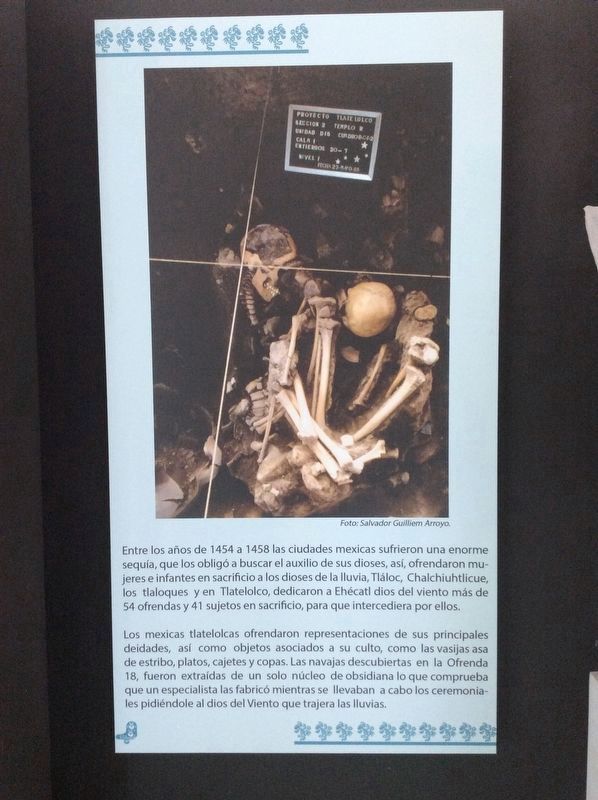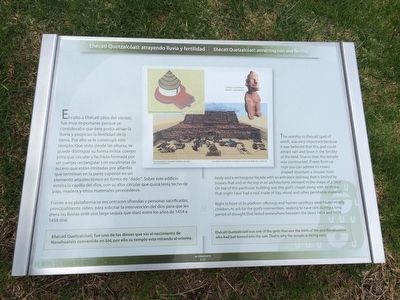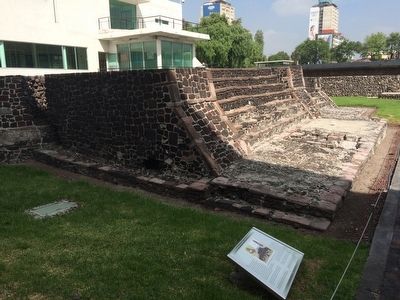Colonia Tlatelolco in Ciudad de México, Mexico — The Valley of Mexico (The Central Highlands)
Ehécatl Quetzalcóatl: attracting rain and fertility
Ehécatl Quetzalcóatl: atrayendo lluvia y fertilidad
Inscription.
El culto a Ehécatl (dios del viento), fue muy importante porque se consideraba que éste podía atraer la lluvia y propiciar la fertilidad de la tierra. Por ello se le construyó este templo. Que visto desde las alturas, se puede distinguir su forma mixta: cuerpo principal circular y fachada formada por un cuerpo rectangular con escalinatas de acceso que están limitadas por alfardas que terminan en la parte superior en un elemento arquitectónico en forma de “dado”. Sobre éste edificio estaba la capilla del dios, con su altar circular que quizá tenía techo de paja, madera y otros materiales perecederos.
Frente a su plataforma se encontraron ofrendas y personas sacrificadas, principalmente niños, para solicitar la intervención del dios para que les diera las lluvias ante una larga sequía que duró entre los años de 1454 a 1458 dne.
Ehécatl Quetzalcóatl, fue uno de los dioses que vio el nacimiento del Nanahuatzin convertido en Sol, por ello su templo está mirando al oriente.
Pie de dibujos:
Reconstrucción hipotética del templo. Dibujo Salvador Guilliem y Luisa Domínguez
Escultura en piedra de Ehécatl-Quetzalcóatl
Isométrico central del Complejo Ceremonial dedicado a Ehécatl
Levantamiento: Salvador Guilliem Arroyo
Dibujo: Fernando Botas Vera
The worship to Ehécatl (god of wind), was very important because it was believed that this god could attract rain and favor in the fertility of the land. Due to that, this temple was constructed. If seen from up high you can admire its mixed shaped structure: a circular main body and a rectangular façade with an entrance stairway that is limited by trusses that end at the top in an architectonic element in the shape of a “dice”. On top of this particular building was this god´s chapel along with its shrine that might have had a roof made of hay, wood and other perishable materials.
Right in front of its platform offerings and human sacrifices were found mostly children, to ask for the god’s intervention, seeking to have rain during a long period of drought that lasted somewhere between the years 1454 and 1458.
Ehécatl Quetzalcóatl was one of the gods that saw the birth of the god Nanahuatzin who had just turned into the sun. That is why the temple is facing east.
English translation of captions:
Hypothetical reconstruction of the temple. Drawing by Salvador Guilliem and Luisa Domínguez
Stone sculpture of Ehécatl-Quetzalcóatl
Central
isometric of the Ceremonial Complex dedicated to Ehécatl
Production: Salvador Guilliem Arroyo
Drawing: Fernando Botas Vera
Topics. This historical marker is listed in these topic lists: Anthropology & Archaeology • Man-Made Features. A significant historical year for this entry is 1454.
Location. 19° 27.037′ N, 99° 8.276′ W. Marker is in Ciudad de México. It is in Colonia Tlatelolco. The marker is at the Tlatelolco Archeological Site on Eje Central near the intersection with Avenida Ricardo Flores Magón. Touch for map. Marker is in this post office area: Ciudad de México 06300, Mexico. Touch for directions.
Other nearby markers. At least 8 other markers are within walking distance of this marker. Superimposed altars (a few steps from this marker); Tzompantli altar (“flag of heads”) of the south. (a few steps from this marker); The Southern Plaza of the Sanctuary (within shouting distance of this marker); Tlatelolco: a well-planned city (within shouting distance of this marker); The Tlatelolco Lovers (within shouting distance of this marker); The Palace (within shouting distance of this marker); The Calendar Temple (within shouting distance of this marker); Tlatelolco’s great temple (“Templo Mayor”): A mirrored image of Tenochtitlan (within shouting distance of this marker). Touch for a list and map of all markers in Ciudad de México.

Photographed By J. Makali Bruton, August 7, 2017
3. Photo of a sacrifice left at the Temple of Ehécatl
This photo is from the small site museum at Tlatelolco. It reads:
Entre los años de 1454 a 1458 las ciudades mexicas sufrieron una enorme sequía, que los obligó a buscar el auxilio de sus dioses, así, ofrendaron mujeres e infantes en sacrificio a los dioses de la lluvia, Tláloc, Chalchiuhtlicue, los tlaloques y en Tlatelolco, dedicaron a Ehécatl dios del viento más de 54 ofrendas y 41 sujetos en sacrificio, para que intercediera por ellos.
Los mexicas tlatelolcas ofrendaron representaciones de sus principales deidades, así como objetos asociados a su culto, como las vasijas asa de estribo, platos, cajetes y copas. Las navajas descubiertas en la Ofrenda 18, fueron extraídas de un solo núcleo de obsidiana lo que comprueba que un especialista las fabricó mientras se llevaban a cabo los ceremoniales pidiéndole al dios del Viento que trajera las lluvias.
Foto: Salvador Guilliem Arroyo
English translation:
During the period from 1454 to 1458 the Mexican cities suffered a great drought that forced them to seek the aid of their gods. They offered women and infants in sacrifice to the rain gods Tláloc, Chalchiuhtlicue and the Tlaloques, and in Tlatelolco they dedicated to Ehécatl, god of the wind, more than 54 offerings and 41 subjects in sacrifice for his intercession for them. The Mexica Tlatelolcas offered representations of their main deities, as well as objects associated with its worship, like vessels with stirrup-shaped handles, plates, bowls and glasses. The knives discovered in Offering 18 were extracted from a single obsidian core which proves that a specialist fabricated them while ceremonies were being carried out, asking the Wind God to bring the rains.
Photograph by Salvador Guilliem Arroyo
Entre los años de 1454 a 1458 las ciudades mexicas sufrieron una enorme sequía, que los obligó a buscar el auxilio de sus dioses, así, ofrendaron mujeres e infantes en sacrificio a los dioses de la lluvia, Tláloc, Chalchiuhtlicue, los tlaloques y en Tlatelolco, dedicaron a Ehécatl dios del viento más de 54 ofrendas y 41 sujetos en sacrificio, para que intercediera por ellos.
Los mexicas tlatelolcas ofrendaron representaciones de sus principales deidades, así como objetos asociados a su culto, como las vasijas asa de estribo, platos, cajetes y copas. Las navajas descubiertas en la Ofrenda 18, fueron extraídas de un solo núcleo de obsidiana lo que comprueba que un especialista las fabricó mientras se llevaban a cabo los ceremoniales pidiéndole al dios del Viento que trajera las lluvias.
Foto: Salvador Guilliem Arroyo
English translation:
During the period from 1454 to 1458 the Mexican cities suffered a great drought that forced them to seek the aid of their gods. They offered women and infants in sacrifice to the rain gods Tláloc, Chalchiuhtlicue and the Tlaloques, and in Tlatelolco they dedicated to Ehécatl, god of the wind, more than 54 offerings and 41 subjects in sacrifice for his intercession for them. The Mexica Tlatelolcas offered representations of their main deities, as well as objects associated with its worship, like vessels with stirrup-shaped handles, plates, bowls and glasses. The knives discovered in Offering 18 were extracted from a single obsidian core which proves that a specialist fabricated them while ceremonies were being carried out, asking the Wind God to bring the rains.
Photograph by Salvador Guilliem Arroyo
Credits. This page was last revised on April 17, 2020. It was originally submitted on January 4, 2016, by J. Makali Bruton of Accra, Ghana. This page has been viewed 483 times since then and 26 times this year. Photos: 1, 2. submitted on January 4, 2016, by J. Makali Bruton of Accra, Ghana. 3. submitted on August 12, 2017, by J. Makali Bruton of Accra, Ghana.

